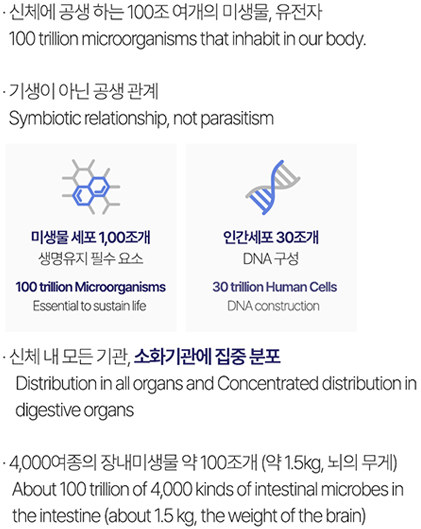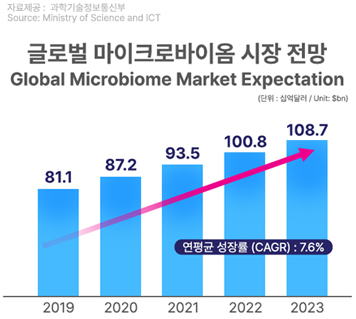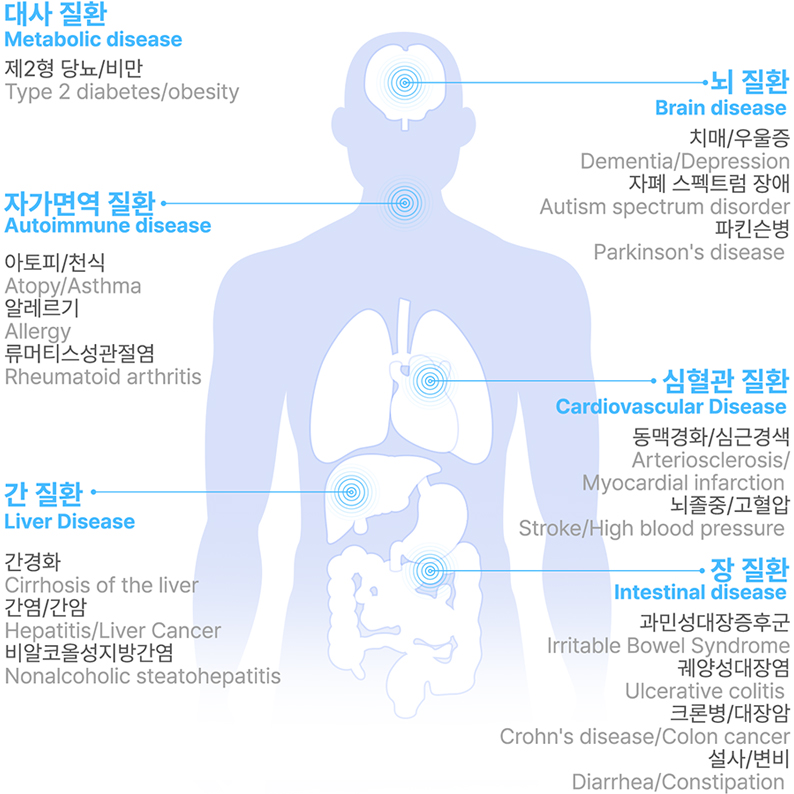HOME / Competitiveness / Microbiome
Microbiome
마이크로바이옴 Microbiome


마이크로바이옴(미생물군집)은 우리 몸의 위장관에 서식하는 약 100조 개의 미생물(박테리아, 균류, 바이러스, 고세균, 원생동물, 진핵생물)로 구성됩니다.
마이크로바이옴은 병원체로부터 숙주를 보호, 식이 영양소와 약물을 대사화, 식이 성분의 흡수 및 분포를 유도, 위장관과 중추 신경계(‘장-뇌 축’) 간 상호작용을 합니다.
장내 마이크로바이옴은 인간이 분해할 수 없는 영양소의 분해를 도와 소화되어 흡수할 수 있도록 도와주는 역할을 하고 있으며, 물질대사나 면역체계에도 관련되어 있는 것으로 보고되고 있습니다. 또한 비만, 소화계, 심혈관계, 면역계, 심지에 뇌질환까지도 연계되어 있다는 연구 결과들이 보고되면서, 장내 마이크로바이옴과 인간의 건강과의 밀접한 관계에 대한 관심도가 높아지고 있습니다.
The microbiome consists of about 39 trillion microorganisms (bacteria, fungi, viruses, archaea, protozoa, and eukaryotes) that inhabit the gastrointestinal tract of our body.
The microbiome protects the host from pathogens, metabolizes dietary nutrients and drugs, induces absorption and distribution of dietary components, and interacts between the gastrointestinal tract and the central nervous system (the ‘gut-brain axis’).
The gut microbiome plays a role in helping humans digest and absorb nutrients that cannot be broken down, and is reported to be involved in metabolism and the immune system. Also, as research results have been reported that obesity, digestive system, cardiovascular system, immune system, and even brain disease are linked to the microbiome, interests between the gut microbiome and human health is increasing.
마이크로바이옴 시장 동향 Microbiome Market Trends

마이크로소프트 창립자 빌 게이츠는 ‘세계를 바꾸게 될 3가지는 면역 항암제, 마이크로바이옴, 치매 치료제’ 라고 언급한 바 있습니다. 2017년 9월에는 우리나라 과학기술정보통신부 등 관계부처들이 ‘제3차 생명공학 육성 기본계획’을 수립하고 발표했습니다. 기본계획에서는 미래 유망기술 분야로 합성생물학, 유전자교정과 더불어 마이크로바이옴을 선정하고 경쟁형 ‘한우물’ 연구 지원을 추진해 나가기로 했습니다.
장내 마이크로바이옴이 비만, 당뇨, 면역, 아토피, 신경계, 암 등 많은 질환과 관련되어 있다는 연구결과는 질환치료와 진단에 마이크로바이옴을 이용하려는 방향으로 진행되고 있습니다. 이에 따라 글로벌 제약사와 바이오 벤처들이 이 시장에 진입하기 위해 빠르게 움직이고 있습니다. 또한 Clostridium difficile 감염증 같은 질환치료를 위해 장내 마이크로바이옴 전체를 이용하는 ‘대변이식 시술’ 도 전 세계적으로 확대되고 있습니다.
또한 마이크로바이옴을 이용한 면역항암제 등 신약 개발을 위해 국내 제약사와 바이오 벤처들이 연구를 진행하고 있습니다.
이처럼 현재 국내의 마이크로바이옴 시장은 프로바이오틱스와 연관된 기능성 제품이 주를 이루고 있지만 향후 비만, 암, 당뇨, 소화기계 질환, 치매 등 뇌 관련 질환 등 다양한 질환의 치료제 개발로 시장이 확대될 것이며, 마이크로바이옴을 이용하는 개인맞춤형 식품이나 치료 등으로 확장될 것으로 예상됩니다.
Microsoft founder Bill Gates once said, "The three things that will change the world are immuno-oncology drugs, the microbiome, and the treatment of dementia." In September 2017, relevant ministries such as the Ministry of Science and ICT in Korea established and announced the ‘3rd Basic Plan for the Promotion of Biotechnology’. In the basic plan, the microbiome along with synthetic biology and gene editing are selected as promising future technology fields and is to be supported by the government.
Research results suggesting that the gut microbiome is related to many diseases such as obesity, diabetes, immunity, atopy, nervous system, and cancer is progressing in the direction of using the microbiome for disease treatment and diagnosis. Accordingly, global pharmaceutical companies and bio ventures are moving rapidly to enter this market. In addition, ‘fecal transplantation’ using the entire intestinal microbiome for the treatment of diseases such as Clostridium difficile infection is expanding worldwide.
In addition, domestic pharmaceutical companies and bio ventures are conducting research to develop new drugs such as immunotherapy using the microbiome.
As such, the current domestic microbiome market mainly consists of functional products related to probiotics. But in the future, It is expected that the market will expand to personalized food and treatment by developing treatments for various diseases such as obesity, cancer, diabetes, digestive system diseases, and brain-related diseases such as dementia.
장내불균형 Dysbiosis
장내 미생물 생태계(마이크로바이옴)의 균형이 무너지는 Dysbiosis가 발생하면 아래와 같은 질병들이 발생합니다.
Dysbiosis occurs when the balance of the intestinal microbial ecosystem (microbiome) is disrupted, causing the following diseases.

장뇌축 기능 Gut-Brain Axis Function
마이크로바이옴과 뇌는 동시에 발달하여 상호작용을 합니다. 마이크로바이옴은 신경 회로 형성, 뉴런(신경) 흥분성, 식욕 조절 호르몬과 관련된 섭식 행동에 영향을 미칩니다. 소장에는 영양소를 감지하고 반응하는 많은 수의 신경이 분포하고 있는데, 이 신경은 뇌의 다양한 부분, 특히 렙틴의 방출을 통해 포만감을 조절하는 시상하부, 그리고 그렐린의 방출을 통해 식욕을 조절하는 위와 십이지장의 장내 분비 세포에 연결되어 있습니다.
렙틴 증가는 포만감을 증가시키는 반면 그렐린의 감소는 식욕을 억제하는데, 두 가지 모두 시상하부의 수용체 발현을 통해 이루어집니다. 렙틴의 주요 기능은 지방 조직의 발현 양을 조절하는 것입니다.
The microbiome and the brain develop and interact at the same time. The microbiome influences the formation of neural circuits, neuronal excitability, and eating behavior related to appetite-regulating hormones. Nutrient-sensing and responsive nerves are distributed in the small intestine, which include various parts of the brain, particularly the hypothalamus, which regulates satiety through the release of leptin, and the stomach and duodenum, which regulates appetite through the release of ghrelin. It is connected to the secretory cells of the intestinal tract.
An increase in leptin increases satiety, while a decrease in ghrelin suppresses appetite, both through the expression of receptors in the hypothalamus. The main function of leptin is to regulate the amount of expression in adipose tissue.
비만과의 관계 Relationship with obesity
2006년 제프리 고든 박사(워싱턴대학, 미국)의 연구 발표로 마이크로바이옴의 인체 영향에 대한 인식의 변화가 있었습니다. 제프리 고든박사는 비만 쥐와 마른 쥐의 분변을 각각 무균 쥐에 주입한 결과 비만 쥐의 분변을 주입한 무균 쥐가 마른 쥐의 분변을 주입한 무균 쥐보다 빠른 시간 내에 비만이 되는 것을 확인하고 비만인 사람과 마른 사람의 장내 마이크로바이옴이 다르다는 연구 결과를 2006년 네이처에 발표하였습니다.
그 후 비만에 대해 불일치하는 여자 쌍둥이의 분변을 무균 쥐에 주입한 결과 비만쌍둥이로 부터 분변을 주입받은 쥐가 마른쌍둥이로부터 분변을 주입받은 쥐보다 빨리 지방이 증가하여 비만이 되는 것을 확인하고 2013년에 사이언스에 발표하였습니다. 이런 결과들은 장내 마이크로바이옴이 비만과 밀접한 관계를 가지고 있습니다는 것을 알게 해 주었고, 사람들에게 큰 반향을 일으켰습니다.
The publication of a study by Dr. Jeffrey Gordon (University of Washington, USA) in 2006 changed the perception of the effects of the microbiome on the human body. Dr. Geoffrey Gordon injected the feces of obese and lean mice into aseptic mice, respectively, and confirmed that the aseptic mice injected with the feces of obese mice became obese in a faster time than the sterile mice injected with the feces of lean mice. A study on the difference between the intestinal microbiome of skinny and skinny people was published in Nature in 2006.
After that, a result of injecting the feces of female twins disagreeing about obesity into sterile mice, it was confirmed that the mice injected with feces from the obese twins increased fat faster than the mice injected with feces from the lean twins is published in Science in 2013. These results showed that the gut microbiome is closely related to obesity, and it has had a huge impact on people.
